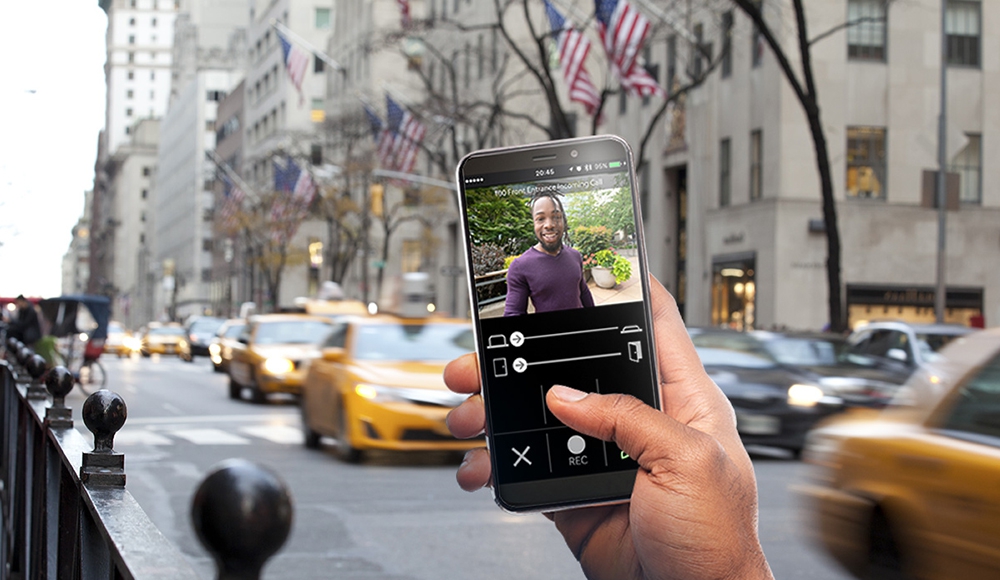Home is where the security is Video intercom systems provide critical safety option for homeowners

By Cory Harris, Editor
Updated 7:59 AM CDT, Mon March 15, 2021

YARMOUTH, Maine—Knowing that you and your family are safe and secure in your own home offers peace of mind, especially if you have the necessary technology to ensure that everyone in your house is protected.
Gone are the days where looking through a peephole, answering a doorbell or pressing a button on a wall intercom were pretty much the only options to verify a person’s identity. We’ve also advanced past the simple security camera with a motion sensor that sends alerts to a central monitoring station.
These days, homes are classified as “smart,” with advanced Internet-connected devices such as two-way audio and video cameras, video doorbells and smart locks expanding the modern landscape of residential security.
Video intercom systems have also emerged as an option in the residential security space. These systems provide the convenience and safety needed at a front door or gate, with the ability to see and hear who’s at your door without even getting near it. In addition, by using an app on your smartphone or another smart device, homeowners don’t even have to be home to see who’s at their door.
Valuable Systems
.jpg) Paul Hefty, Technical Sales and Support Engineer at Aiphone, a manufacturer of security access control and video intercom systems, told Security Systems News that the biggest advantage that video intercom systems offer in the area of residential security is that homeowners can view who is at the door without having to open the door.
Paul Hefty, Technical Sales and Support Engineer at Aiphone, a manufacturer of security access control and video intercom systems, told Security Systems News that the biggest advantage that video intercom systems offer in the area of residential security is that homeowners can view who is at the door without having to open the door.
“However, in some cases you have a limited view, so someone could be hiding out of view of the door station camera,” he added. “Simply adding an ONVIF Profile S camera to the system can provide a more complete picture of who is at the door. If the internal master has a picture-in-picture mode, the homeowner can view both images before allowing entry.”
Residential video intercom systems have various applications, with the most popular application being for gated residences, according to Hefty.
“Other applications include in-home businesses where there is a separate entrance for visitors of those businesses,” he said. “Another application we see often is when older family members are living in a small ‘mother-in-law suite’ on site. In this application the video camera is on the master station. This allows for two-way video communication between stations, making it easier to check in on the grandparent, or the individual in residence.”
Hefty pointed out the importance of having video intercom systems installed in homes, especially when it relates to access control.
“A lot of homes have added a video intercom at the door and have it integrated with an app,” he explained. “This is great until they lose Internet service or have bad cell reception. When that occurs, no one is answering the door even if you’re home. Having a physical master station in the house will ensure that the door gets answered even when the Internet is down.”
During the COVID-19 pandemic, video intercom systems have served a more prominent role in the area of residential security, according to Hefty.
“Residential intercoms have been around for many years in one form or another, but video intercoms are extremely valuable as they allow you to see and communicate with visitors, while maintaining your safety,” Hefty said. “During the COVID-19 pandemic this became even more important. As people adapted to the pandemic and tried to isolate, they would have more items delivered, including groceries, fast food and other items. Having a video intercom allowed people to be able to see and communicate with the delivery person, allowing them to leave items at the door. They could then open the door after the person had left, ensuring their safety.”
Emerging Technologies
New technologies have emerged in the area of residential video intercom systems, including touchless sensors and network video intercom systems.
“In some commercial facilities, we are seeing residential systems incorporate touchless sensors into the video door station,” Hefty said. “Additionally, some residences are moving to network video intercom systems as it offers the most flexibility. The networked systems can tie into ONVIF Profile S surveillance cameras, as well as be installed at multiple locations. In some cases, they want multiple buildings on a site to all answer a main door or gate. In other cases, they want master stations at their main residence, as well as their vacation home, so that they can answer the door in any circumstance.”
Hefty explained how the technology works for home intercom systems.
“In our smaller systems we are running the video and audio over two wires, and for door release, we run an additional two conductors,” he explained. “This makes it more streamlined for new and retrofit installations. In our more complex and flexible systems, we are using network connectivity. All we need is a simple PoE [Power over Ethernet] network connection at each station. Because we do not have a central server, systems are easy to put together and can be expanded at any time. All customers need to figure out is how many door stations and how many masters they require. If circumstances change, stations can be easily added.”
Hefty added that one of the more important factors when installing a home intercom system is making sure you get the correct system for the application.
“Sometimes it is a simple one door, one master video intercom system; other times it could be more complex,” he explained. “Figuring out how many devices are required and what features are needed is important, but so is figuring out how things will be wired. Understanding this will ensure that the correct system is installed.”
Impact on Security Industry
Hefty noted that residential video intercoms have been a very important part of the security industry for a while, and will continue to serve as a critical component in the area of home safety.
“While cameras and locks will always be the items at the top of the list, the video intercom is what is letting the visitor in the door,” he explained. “That visitor could be your next big client, your lunch being delivered, a fellow employee with a bad access card, or your neighbor from down the street. Video intercoms also offer a hybrid solution for residential security – allowing for users to both visually confirm identity and communicate directly with those requesting access. It’s a comprehensive security and safety tool.”
Comments